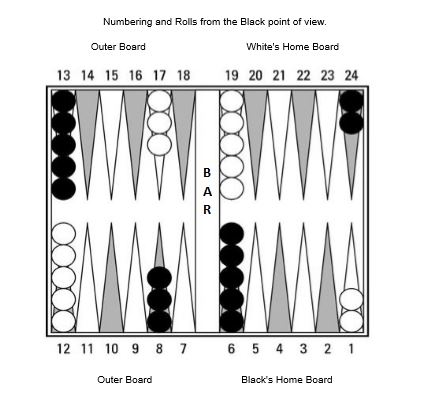Last updated on May 21, 2024
Backgammon notation is a method that allows the description of backgammon play to be written in a standardised manner. The notation describes the dice rolls, checker moves, hits, re-entries from the bar and bearing off. An entire game can be precisely recorded and therefore studied, replayed or analysed by backgammon software. Before 1976 backgammon notation was not standardised and every author would present their own system for describing the play. This made it difficult for students of the game, as they would need to learn a new system of notation with every book they read. A more complete list of Playing Guides is available on this link.
Standard notation
In 1976, Paul Magriel published his classic book Backgammon and introduced a new notation system that was simple and easy to adopt. It was so effective that virtually overnight it became the world standard notation system for backgammon. Almost every backgammon book or article published since has used the Magriel notation system.
If you want to become a serious player and truly enjoy your luxury backgammon set you will need to study the theory of the game. Reading books and articles will help advance your game, as will using backgammon software to analyse moves. However, it is essential that you can read the standard notation if you are going to benefit from the effort.
Numbering
Each of the points on the board is numbered from 24 to 1 as shown in the image below. In this instance, the board is numbered from the perspective of the black checkers. The reverse numbering would occur if viewing the board from white’s perspective.
Dice rolls are noted as either 3-1 or 31, indicating a roll of three on one die and one on the other. Moves are recorded using a / to separate the starting position of a checker from its final position. Assuming an opening roll of 3-1, the moves would be denoted as 3-1: 8/5 6/5
Hits
If a move results in a checker being hit, this is indicated by adding an asterisk (*) to the number indicating the point on which the checker was hit. For example, 13/7* denotes a checker moving from the 13-point and hitting an opposing checker on the 7-point. Additionally, the notation 6-2: 13/7*/5 denotes a move corresponding to a roll of 6-2 whereby a checker moves from 13 to 7 hitting a checker using the roll of 6. The checker then moved onwards to a final position on the 5-point using the roll of 2.
Doubles
Double rolls are recorded slightly differently as multiple checkers could be moved from a single point. The number of checkers that are moved from a single point following a double would be recorded in a set of parentheses immediately after the move. For example, the moves resulting from a roll of 2-2, would be: recorded as 2-2: 6/4(3) 13/11. This indicates that three checkers were moved from the 6-point to the 4-point, but only one checker was moved from 13 to 11.
Entering from the bar and bearing off
Lastly, the words ‘bar’ and ‘off’ are used to describe moves where checkers are entered from the bar or taken off the board when bearing off. For example, 6-5: bar/19 13/8, would indicate a player had re-entered from the bar using the roll of 6. Then they moved a second checker from 13 to 8 to complete the move. When bearing off, 5-2: 5/off 2/off, would indicate a roll of 5 and 2 allowing checkers from both of these points to be removed from the board.
At Deluxe Backgammon we recommend learning this simple notation. It can be learnt in a matter of minutes and will make the study of the game so much easier.


I have recently made a serious attempt at improving my backgammon reading and studying several books. I must admit I found the backgammon notation difficult to follow at first. However, then I came across this post, which describes backgammon notation and how it works, in really simple and easy to understand terms. Much better than the description in the book! Thanks for the great post on backgammon notation.
Hi Kitty, at Deluxe Backgammon we are pleased the backgammon notation post was useful. If you are keen to improve your backgammon, you might like to read some of the Deluxe Backgammon reviews of backgammon books. Thanks for taking the time to comment, Jason